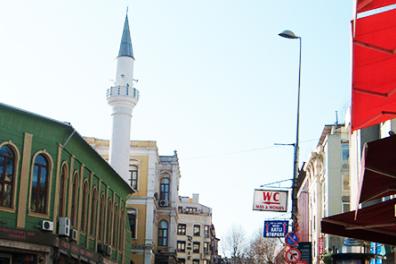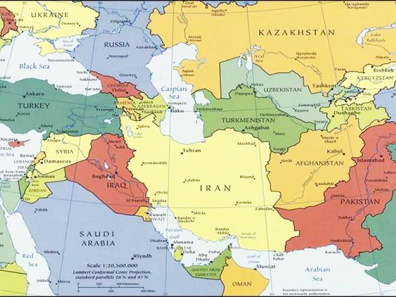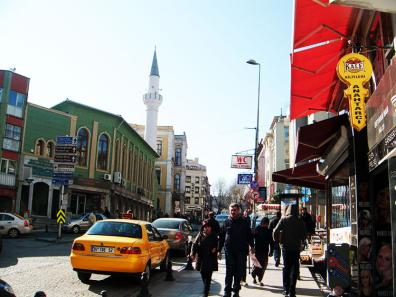Turkish, the language of Eurasia

At the heart of the Turkish-speaking world is, of course, the Turkish language of Turkey, with its population - currently 83 million and expected to rise to almost 100 million by 2030 - accounting for half of all Turkish language speakers. Then there's Turkey's economic boom of recent decades, which has placed it among the world's top 20 economies. And its geographical location in the middle of three continents makes it a bridge between West and East, North and South, and multiple cultures from the Balkans to the Middle East. This dossier, devoted to the Turkish world, will cover all these dimensions, but we will touch on a few of the major characteristics of contemporary Turkish.
.

The Turkish language
Turkish (Türkçe), part of the Oghuz group of the large Altaic family, bears all the typological particularities of its linguistic family: the agglutinative character thanks to suffixation (perfectly ordered declension of nouns and conjugation of verbs), vowel harmony (vowels follow one another in a precise order), absence of gender (neither masculine, nor feminine, nor neuter), regular SOV (subject-object-verb) word order, except in literature, especially poetry and everyday language. Turkish has a casual system, like Latin, with five cases of the noun: directive, ablative, locative, genitive and accusative.
Lexically, throughout its history, Turkish has stood out for its permeability to borrowing from other languages; since Islamization from the 11th century onwards, it has borrowed mainly from Arabic, Persian, then in the 19th and 20th centuries from French and more recently from English.
Alphabet
After using Arabic characters since the 11th century, in 1928 the Turks adopted the Latin alphabet, close to that of French, with 29 letters including 8 vowels. This is a phonetic alphabet, in which each letter is always pronounced and never changes pronunciation. There is no diphthongation or nasalization. There are no guttural sounds. No grouping of consonants or vowels. As a general rule, letters follow the rhythm of a vowel, a consonant. Less often, vowels can be found side by side in words of foreign origin, mostly borrowed from Arabic: saat (the hour, the watch), fiil (verb, action), etc.
History of the Turkish speciality at Inalco
The teaching of Turkish in France has a history of several centuries. Turkish was one of the founding languages of a school of oriental languages as early as the 12th century, the forerunner of Inalco and French orientalism. It was Colbert who, in 1669, created the "École des jeunes de langue" to teach Turkish, Arabic and Persian to young Frenchmen sent to Istanbul in this school set up within the French Embassy named after the "Jeunes de langues" (Dil Oğlanları) intended to train interpreters to serve trade and diplomacy. This gave rise to a long line of drogmans serving the chancelleries of European states. Drogman (interpreter) is derived from the Arabic word "tercüman", which was translated into Turkish and then into French as "truchement". Turkish has been taught in France uninterruptedly since 1795.
The "Turkish" specialization at Inalco offers initial and continuing training, with a focus on the Turkish-speaking world through the teaching of Turkish languages. The program is open to holders of a French baccalauréat or equivalent diploma, and to non-baccalauréat holders after passing a French test and an examination by the pedagogical committee. The program is open to French- and Turkish-speaking students, as well as international students.
From the second year of the bachelor's degree, students can specialize in one of the following professional fields: Language Didactics, International Business, International Relations, Intercultural Communication and Training.
The range of courses on offer, which extends to master's and doctorate levels, is aimed at a diverse public and takes into account the needs of young graduates and retirees, as well as professionals looking for an introduction to Turkish language and civilization.
The "Turkish" specialization in foreign and regional languages, literatures and civilizations (LLCER) aims to equip students with written and oral communication skills on the scale of the Turkish-speaking world, enabling them to enter the workforce or teaching and research.
In addition to linguistic mastery, the curriculum emphasizes contemporary literature, history, culture and society. Its aim is to provide access to careers in the civil service, commerce and industry, among other possibilities. It prepares students for the translation of increasingly specialized texts and documents with a view to a Master's degree.
Turkey's relations with the countries of the European Union, as well as its commercial dynamism in Central Asia, the Middle East and Africa, are key factors opening up new horizons. The Turkish bachelor's degree prepares students for developing international economic and commercial exchanges (over 400 French companies are established in Turkey, some of which have been there for a very long time, such as Renault, and just as many Turkish companies in Central Asia).
LLCER "Turkish" specialization prepares students for:
- jobs in commercial, industrial and service companies working with Turkey and the Turkish world,
- jobs in the civil service: in particular those in the Ministry of Foreign Affairs, the competitive examination for the cadre d'Orient and the French Office for the Protection of Refugees and Stateless Persons (OFPRA),
- careers in international organizations (European Union, UNESCO, Council of Europe, OECD, etc.),
- careers in international organizations (European Union, UNESCO, Council of Europe, OECD, etc.).),
- teaching in secondary schools (FLE) and universities. Turkish is one of the ten languages used in competitions at the Quai d'Orsay.
Further studies
- Master 1, specialties of the Master's programs offered at Inalco,
- Linguistic programs (French as a foreign language -FLE, diversity of languages, translating, interpreting),
- Professional programs (CPEI- International Trade, HEI- Higher International Studies).
Inalco's LLCER "Turkish" specialization is the only historical center in the Paris region to offer a complete training program, from initiation to doctorate (LMD).
In keeping with its tradition, Inalco is one of the few establishments in Europe to offer a training program that provides access to the entire Turkish-speaking world. In addition to Turkish from Turkey, Azerbaijani, Kazakh, Tatar, Uyghur and Uzbek are taught.
As such, the course is attractive not only to French students, but also to European students, who can find at Inalco a complete training course for studies carried out in their home country.
Sibel Berk-Bozdémir
Lecturer
Linguistics and Didactics of Modern Turkish
Eurasian Department
Member of the EA 4514 PLIDAM laboratory
Inalco
Header image: Istanbul, Turkey. DR.
